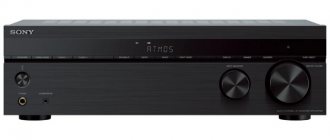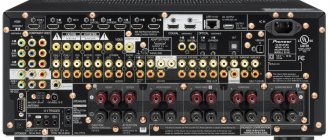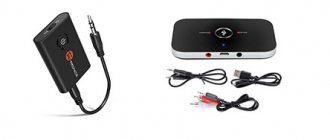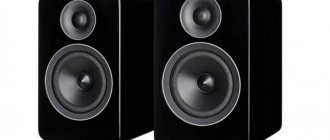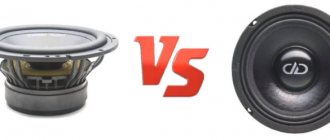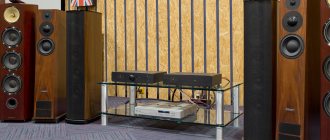An audio amplifier and AV receiver are used to build a room's acoustic system. This system is used for watching movies in a home theater or listening to music.
- Amplifier
Receiver
Type
Pre-amplifier (preamplifier) - receives the audio signal and amplifies it to the value necessary for normal operation of the power amplifier.
Power amplifier (mono amplifier) – amplifies the audio signal to the value necessary for normal operation of the speaker system.
Stereo amplifier (integrated amplifier) – increases the power of two-channel sound. Consists of a power amplifier and pre-amplifier. Such a device is cheaper than two separate amplifiers and does not require a connecting wire. The stereo amplifier is used only for listening to music in two-channel mode.
An AV receiver is a multi-channel amplifier that decodes and processes audio and video signals of different standards. Unlike an amplifier, an AV receiver is capable of working not only with analog, but also with digital signals. Includes several amplifiers, signal processors, decoders.
The main purpose of an AV receiver is to provide sound tracks for films in a home theater. But its scope of application is much wider, since an AV receiver is a universal device that allows you to amplify sound, play music, as well as photo and video files (some models) from various media, and receive FM radio signals.
Due to the versatility and balance of various tools, an AV receiver is the most common choice.
Important: to listen to music, it is better to purchase a stereo amplifier. Although an AV receiver can replace an amplifier, a dedicated device is still preferable to a universal one. When playing two-channel stereo music, the remaining channels will not be needed (there is no point in overpaying for the receiver). Therefore, music lovers should choose an amplifier, and movie lovers should choose an AV receiver.
AV processor is an AV receiver that does not have an amplifier (it does include pre-amplifiers). Therefore, the device works in tandem with an external amplifier. This disadvantage is compensated by a large number of tools for processing audio recordings (including the ability to play audio and video files). The main function is to adjust multi-channel sound for a specific room.
An AV processor is better suited than an AV receiver to create a high-level speaker system designed for connoisseurs of surround music. True, the AV processor + external amplifier (at least 5) + cables will cost more than buying a standard AV receiver.
AV amplifier - an AV receiver without a tuner cannot play the role of a radio receiver. Additionally, it does not play audio or video files.
In addition to the listed types, specialized amplifiers for subwoofers and headphones are used to realize the capabilities of these devices. There is also a phono stage that works in conjunction with a vinyl disc player. A phono stage amplifies the sound signal from a record player's pickup.
What is a receiver?
Multichannel amplifier that converts audio and video streams
called a receiver. Most often, such a device is used for:
- Significant increase in sound flow.
- For converting audio signals in systems such as home cinema.
The first receiver appeared in the era of development of radio broadcasting, which fell in the 20s of the twentieth century. The first receiver looked like a combined radio receiver with an amplifier. The name “receiver” is in English and is translated as receiver or receiver. Most often, the receiver is the dream of any music lover or cinema lover.
The receiver also gained significant popularity and demand during the era of development of the film industry. Initially, it was improved by adding the most primitive processors to the design, which processed the sound and gave it surround sound. Later, development began on processing multi-channel audio streams.
The work of the receiver can be felt in the cinema hall, when the sound when watching a film has a comprehensive, enveloping and three-dimensional effect. is the pioneer in the creation of surround sound. The creators changed the principle of sound recording. For these purposes, the sound was laid out in the form of a mathematical matrix with special encoding on stereo tracks.
When choosing a receiver, you must be guided by the power parameters. An equally important parameter is the sound amplification transformer. The most optimal is toroidal, has small dimensions, produces high power, and does not heat up during operation.
The receiver can have two construction schemes:
- Discrete
. Consists of transistors. - Integral
. Consists of microcircuits, typical for models in a miniature case and in a budget pricing policy.
Depending on the design features and manufacturer, the price range for the receiver is formed.
Circuit design
Semiconductor (transistor) – resistant to overloads, short circuits and vibrations, does not require special cooling. Most amplifiers and AV receivers are solid state.
Tube - in terms of performance it is inferior to the previous version, but it compares favorably with its characteristic “tube” sound. Many music lovers consider this sound more pleasant than the sound produced by a transistor model. Cons: high price, large dimensions, short lamp life. Expensive professional amplifiers and AV receivers are often tube-based.
Important: due to the design features and principles of operation, lamp equipment is more expensive than transistor equipment. Therefore, it is not advisable to purchase the cheapest tube model with the expectation of high-quality sound - such a device will quickly fail. It’s better to buy a reliable semiconductor amplifier or AV receiver for the same money, especially since not everyone can feel the difference in sound.
Hybrid - combines transistors and lamps. This technique is rare.
What is an amplifier?
Devices whose purpose is to amplify the power of an electrical signal include an amplifier. This device can be either a single whole and a separate element or be a component and complement to any sound-reproducing device. An amplifier is the final device in any audio chain.
Depending on the scope and design, amplifiers are:
- Household.
- Professional.
- Single-cycle.
- Two-stroke.
It is worth noting that the amplifier can be located and complement absolutely any audio device
. The signal that enters the device usually has very weak power, and in order to transmit the signal further, an amplifier is necessary. All equipment that is equipped with speakers has similar devices. Household appliances are characterized by the presence of amplifiers that operate in the audio range to which human hearing is tuned.
In industry you can also find audio amplifiers, they are presented in the form of broadcast power amplifiers. The purpose of this device is to amplify and transmit the sound signal at sites, enterprises, and stadiums. Roughly speaking, such a device is a transmitter of information for large areas with a high degree of sound power.
In appearance, the unit can be of various designs and sizes. Depending on the scope of use and purpose, the amplifier may have a protected and sealed housing, or have miniature dimensions.
Channels
Unlike a conventional amplifier, which has one (mono) or two (stereo) amplification channels, the AV receiver has a built-in multi-channel amplifier. The number of channels is designated 2.1; 5.2; 8.4, where the first number corresponds to the number of channels for speakers, and the second – for a subwoofer.
Multiple channels provide surround sound. The more such channels, the larger the sound. In addition, a large number of channels will allow you to improve the acoustic system in the future by purchasing new speakers. If you choose an AV receiver with a small number of channels, then it will be impossible to increase this parameter, which means you will have to buy a new device.
At the same time, a larger number of channels increases the price of the AV receiver and the entire speaker system as a whole (purchase of speakers, subwoofers).
The most common formats.
- 5.1 – 1 center + 2 front (right and left) + 2 rear (right and left) + 1 (for subwoofer). Optimal balance of high-quality surround sound and relatively low price. In addition, this solution is characterized by ease of configuration. The vast majority of content with multi-channel audio is created in 5.1 format.
- 7.1 – differs from the previous version by two additional channels. As a result, the sound is more spacious, but the price of the system increases and its setup becomes more complicated. At the same time, the amount of content released for the 7.1 format is less than for 5.1.
- 9.1 – differs from the previous version by two additional channels. The advantages and disadvantages of this solution are similar to the 7.1 format: even higher quality surround sound results in increased cost of the system and more complicated setup. And there is even less content for this format.
There are also other formats: 2.1; 3.1; 5.2; 6.1; 6.2; 7.2; 8.4; 9.2; 11.1; 11.2; 13.2. The advantages and disadvantages of these AV receivers are assessed in the same way as in the previous cases.
Pay attention to the number of channels for subwoofers. This parameter varies between 1-4, but formats with 1-2 channels are most often used. The more channels, the more blurred low-frequency sounds become, which again has a positive effect on the spaciousness of the sound stage in the room.
Important: if the room area does not allow placing more than 5 speakers, then use additional channels to improve playback quality. You can either connect the front channels using a bi-amplifier circuit (relevant for two-way speakers with two pairs of terminals), or provide sound amplification in the kitchen or bedroom.
What is the amplifier used for?
First of all, the amplifier is used to play music in stereo format. That is, it provides amplification for only two channels. And for music you don’t need more. In addition, good amplifiers are capable of “boosting” any speaker system (at an acceptable level). And this is another advantage of them. Good sound amplifiers (stereo) cost the same as a high-quality receiver. Therefore, there is not much difference in price. The only difference lies in the technical characteristics. And they need to be analyzed in more detail.
The amplifier has only two amplification channels. And this is its main difference from the receiver. In addition, usually such a device does not indulge the user with the ability to connect various sound sources. Further, sound amplifiers (stereo) are intended exclusively for listening to music. That is, you can also watch movies, but the sound will not be the same. Also, amplifiers are usually equipped with loudness compensation, while receivers (budget ones) are deprived of this very useful option.
Output power per channel
volume depends on this parameter . The more powerful the amplifier and AV receiver, the more expensive and heavier it is.
Output power per channel has two meanings: “nominal” (the number in the device passport) and “actual”. “Nominal” power indicates the ability of the amplifier to output a similar parameter to connected devices with the corresponding characteristics in a short period of time. “Actual” power means the power parameter that is continuously output.
Important: to determine the actual power, divide the rated power by 2 - most receivers are no more than 50% efficient.
The choice of amplifier or AV receiver based on output power is determined by the size of the room and the characteristics of the connected speakers.
- For a small room (15-25 m2), the optimal solution would be a device with 100-150 W per channel, for a spacious room - a model with a power parameter of 150 W (40-50 m2).
- The power ratings of the AV receiver and speakers should ideally match or, in any case, their difference should not exceed 15%. Otherwise, the AV receiver with a peak signal even at medium volume can damage the speaker.
It is advisable to purchase a device with a power reserve - in this case, the scale of the sound stage and sound dynamics (the difference between “quiet” and “loud”) are improved. Thus, the viewer will feel all the richness of various sound effects in modern films or sudden changes in dynamics in symphonic music from piano-pianissimo (quiet and very quiet) to forte fortissimo (loud and very loud) and vice versa.
Important: output power may vary under the influence of a number of factors - primarily, fluctuations in the impedance of the speaker system and the level of distortion.
Exposure 3010 S2
Another integrated semiconductor amplifier with a power of 110 watts per channel. It has a sensitivity of 250 mV. The frequency range starts at 20 hertz and ends at 20,000 hertz. Quite good results for a device in the mid-price segment. The amplifier only works with two channels. But this is the main difference from the receiver.
The appearance of the amplifier allows it to be comfortably placed in a variety of interiors. The silver parallelipiped will not stand out and become an eyesore. The device can also be used as a preamplifier in tandem with a receiver. That is, it can be used to create And this is very interesting. A standard screw connector is used as connection terminals. The wires are fixed securely. The power supply is located in the case itself, which somewhat negatively affects the temperature of the device, but overall the indicators are normal.
AC resistance (impedance)
This parameter means the minimum impedance of the speaker system with which the amplifier or AV receiver can operate normally.
The lower the impedance of the speaker system, the higher the actual power of the amplifier. Therefore, lowering the impedance increases the sound volume, but at the same time, more stringent requirements are placed on the amplifier.
AV receivers designed to work with 4 ohm speakers are quite durable. But models designed to connect to 8 Ohm speakers are not suitable for low impedance speakers.
Important: it is strictly forbidden to connect speakers with a lower impedance than that specified in the data sheet to the amplifier, as this will lead to system breakdown. But connecting a speaker with a high impedance to the amplifier will reduce the output power.
Yamaha RX-V767. Part 1
This 7-channel solid-state AV receiver also falls into the “under $1,000” price category. But it has features that are comparable to top-end devices. But don't forget that this is Yamaha, and this company has a corresponding status in the world of audio devices. This receiver is perfect for both music lovers and movie lovers. Among other things, it has the option to increase the picture resolution when playing video, up to the Full HD (1080p) standard. But this is not the main thing. The main thing is that it copes well with music of various genres and is able to reproduce sound from any source.
Interfaces
Wired inputs and outputs
HDMI (digital) – allows you to simultaneously transmit audio and video signals and has high bandwidth. Great for working with high-resolution video content and multi-channel audio. Widely used in TVs, laptops, media centers, smartphones and other equipment. The connection is a special connector.
Coaxial (digital) – used for transmitting multi-channel audio (up to 7.1). Connection – RCA connector.
Component (analog) – designed for transmitting a video signal. The image quality is comparable to digital interfaces. Connection – RCA connector.
Composite – in AV receivers it is used to transmit video signals. Image quality is average. A corresponding connector is provided for connection.
RCA (analog) – used to transmit two-channel audio signals. Widely used in acoustic systems. Connection – 2 connectors.
Other inputs:
- Phono – designed for connecting a vinyl record player to an AV receiver;
- optical (digital) – used for transmitting multi-channel digital audio; unlike the coaxial interface, it is resistant to electronic interference, but is sensitive to wire deformation;
- multichannel (analog) – used to transmit multichannel analog audio; unlike RCA, this interface has more connectors;
- USB – used to connect the receiver to a personal computer or laptop.
Ethernet is a wired interface that is used to connect the AV receiver to a local network.
Other outputs:
- trigger – ensures simultaneous activation of the AV receiver and devices connected to it, for example, a TV or media center;
- mini-Jack 3.5 mm, Jack 6.35 mm – used to connect headphones. Jack 6.35 mm is less common.
MHL is a wired interface for transmitting content (high-resolution video and multi-channel audio) from a portable device to an AV receiver. In addition, such a connection allows you to charge the gadget’s battery from the receiver.
In addition, there is an RS-232 interface. With its help, the receiver connects to a personal computer to control the device from a distance.
Wireless
Wi-Fi – used to connect to a local computer network.
Bluetooth - most often used to transfer music from tablets, smartphones and other portable devices to the speaker system.
Infrared port – allows you to control the AV receiver from a distance.
AirPlay (via Wi-Fi) – used to transfer music, accompanying text (title of work, album, artist), images and videos in streaming format. The receiver plays content directly from the connected gadget. Owners of Apple devices will appreciate this interface.
DLNA – allows you to create a home network for sharing and playing content between devices. Support for this format ensures device compatibility.
Connect whatever you want
Amplifiers have modest switching capabilities, while receivers, on the contrary, have the most extensive switching capabilities among all equipment. Amplifiers must receive a signal from one or more sources (CD player, computer, etc.) in order to then amplify it and feed it to the acoustics. They have several analog inputs and outputs. They don't work with digital data. In addition to the task of an amplifier, receivers are entrusted with the task of decoding and processing recordings of different standards. In addition, receivers are also used to process video signals (new models “pass” the 3D signal from the Blu-ray player to the TV). So receivers are good at not only “analogue”, but also “digital”. In general, even cheap receivers are noticeably superior in functionality to expensive amplifiers.
Receivers (even inexpensive ones like in the photo) impress with a huge number of connectors
The receivers have such an impressive array of connectors that it will be difficult for an inexperienced movie and music lover to figure out what to connect and where without instructions. But the main thing is that even in inexpensive models, the range of capabilities covers the needs of the vast majority of consumers. The latest generation of AV receivers has received some impressive capabilities. These include connecting to a computer, connecting to Apple gadgets (including AirPlay wireless technology), reading files from memory cards.
Connecting Apple gadgets to receivers to play music is usually not difficult
Key controls and some connectors on receivers are often placed on the front panel
Functions
Auto-calibration system – automatic adjustment of multi-channel sound. Auto-calibration is performed using a microphone connected to the AV receiver, which is placed at the listener’s location. The receiver evaluates the quality of sound transmission to the microphone and automatically adjusts it. This system is easy to use - even an inexperienced owner can set up the speaker system.
The auto-calibration system is especially useful if the shape of the room and the location of the listeners (viewers) are unusual.
Automatic volume control – allows you to balance the sound level in case of a sharp change in its dynamics. As a result, loud sounds such as explosions and forte fortissimo will not frighten the listener, and quiet sounds, such as whispers, will be clearly audible.
Surround sound in headphones – simulates multi-channel sound in classic headphones. Useful in situations where you can't listen to music from the speakers, for example, late at night.
Audio return channel – allows you to transmit an audio signal in the opposite direction (from the TV to the AV receiver). This makes it possible to output sound from TV shows to the speakers of the speaker system through the receiver without using an additional cord.
Important: Make sure your TV and AV receiver support Audio Return Channel.
Supports high-definition video - provides detailed and clear images. Depending on the model, the AV receiver can support FullHD resolution (standard for LCD monitors and TVs) or ultraHD (4K), which provides a much more detailed picture.
Important: when purchasing an AV receiver that supports ultraHD format, make sure that the screen resolution is 3840x2160, otherwise you will pay extra money. The required resolution for FullHD is 2 times less - 1920x1080.
Upscaping – increases video resolution to FullHD or ultraHD (4K). This option greatly improves the quality of older video content that was shot at a much lower resolution and doesn't look good on today's larger screens.
3D support – allows you to output video in 3D format. This option is only relevant for TVs or displays that support 3D.
On Screen Display – Displayed on the screen connected to the amplifier or AV receiver. This makes it more convenient to work with the device settings.
Equalizer – used to adjust the sound timbre to suit the user’s preferences (amplification and attenuation of low or high frequency signals). Typically, tone adjustment is made taking into account the genre or style of music being played.
Balance adjustment – increases / decreases the volume of channels, thereby changing the center of the sound stage. This option is relevant for an acoustic system with speakers with different sensitivities.
Tuner – receives a radio signal and broadcasts broadcasts through speakers. The most common is a digital tuner, which, unlike an analog model, does not require you to manually search for the desired frequency every time.
The tuner can pick up signals in the AM/FM range (AM – news and journalistic programs, FM – music) and/or work with Internet radio broadcasting. In the second case, the number of available radio stations increases many times (traditional + special Internet resources).
Multi Zone – allows you to simultaneously work with several devices connected to the AV receiver (the model outputs a signal to each of them separately). For example, you can stream a movie to a home theater in the living room and music to a speaker system in the bedroom. This feature eliminates the need to purchase a new receiver for individual rooms.
Phono stage - useful for working with a vinyl disc player.
Loudness compensation – provides high-quality sound at low volumes. This improves the perception of low and high frequency sounds.
Direct mode – used for the most accurate music playback (in accordance with the sound engineer’s intent).
Standby mode – eliminates the need to turn on the AV receiver every time to listen or watch content, while reducing energy consumption.
Network audio streaming support – allows you to play streaming audio content from a local network or the World Wide Web (via Wi-Fi or Ethernet).
USB media support – useful for playing audio and video from external hard drives and USB flash drives.
Important: check which file systems of the external media the AV receiver supports.
Display – displays information about the operation of the amplifier, AV receiver (including settings, status of outputs and inputs, volume level). The screen is located on the front panel of the device. Indispensable for a large number of settings.
Remote control – makes it possible to control an amplifier or AV receiver from a distance, which increases the comfort of using the device.
In some models, the remote controls are equipped with additional options that make working with the AV receiver even more convenient:
- with display – displays information about the operation of the AV receiver on the remote control;
- trainable – allows the user to assign functions to specific remote control buttons.
Control from a mobile device (via Bluetooth or Wi-Fi) – turns a smartphone or tablet into a remote control. To do this, the appropriate mobile application must be installed on the mobile device. This option simplifies working with the AV receiver and allows you to control the device even through the wall.
Dolby Digital or DTS? Doesn't matter
The key difference between receivers and amplifiers is the ability to decode various digital video and audio signals. After all, the receiver can not only play music like an amplifier, but also provide multi-channel sound in films. There are many options for encoding audio tracks for movie recordings, of which there are two types - Dolby Digital and DTS. Different editions of DVD and Blu-ray (and their image copies) contain audio recordings in different formats. Moreover, a track in one language can be recorded in one of the Dolby Digital versions, and in another - in DTS. Therefore, receivers must understand any audio recording standards... and they do it without any problems.
If previously the difference between budget and premium AV receivers was expressed in the limited support of standards by cheap models, then even budget models of 2012 understand all the key standards of Dolby Digital and DTS. Including advanced standards Dolby TrueHD and DTS-HD Master Audio, which allow you to save the soundtrack on Blu-ray disc without loss of sound quality. So, when buying a receiver, you can rest assured that any DVD and Blu-ray discs or copies thereof will be sounded as expected (but it still doesn’t hurt to check the specifications). Please note that more expensive receiver models use more advanced electronics. Therefore, they are able to decode the signal more efficiently and have greater capabilities for processing or adjusting sound. That is, more advanced receivers are able to create a more accurate and effective sound space.
In addition to working with sound, AV receivers can also handle video correctly. Previously, in the era of analog video, receivers had various inputs for connecting video signal sources and functions for processing it. Nowadays, connecting players and computers is usually done using HDMI and signal processing is not needed (if we talk about HD and Full HD video). Although new models still have analog interfaces. Some receivers can convert low-quality signals into Full HD video. If you have video recordings from DVD or VHS eras, home videos made with an SD camera, etc., then the receiver will be able to display it on the screen in Full HD resolution. But don't expect video quality like Blu-ray discs.
The trend is encouraging to equip middle-class AV receivers ($1000-1500) with an auto-tuning (auto-calibration) system. Using a microphone, the receiver adjusts its parameters so that the listener receives a reliable sound picture (as far as possible in a specific room and with specific equipment). So, even after purchasing a receiver, you can get adequate performance from it even without experience in handling such equipment (manual settings remain available for change).
In addition to the remote control, modern receivers are usually equipped with a microphone for automatically adjusting sound parameters
In the era of digital technology, the need for high-quality sound when listening to your favorite tracks or watching an exciting movie is very urgent. The presence of poor-quality, weak sound can, at a minimum, cause irritation. To help solve such a problem, a decision may come to install additional equipment in the form of a receiver or sound amplifier. At first glance, we are talking about similar or identical devices, but in fact this is a misconception; they are completely different not only in terms of design, but also in terms of cost policy.
Adviсe
- When choosing a suitable amplifier or AV receiver, adhere to the following scheme: first pay attention to the flagship samples of well-known brands, and then move down the corresponding lines and stop at the model in which the balance between price and functionality will be optimal.
- Be sure to listen to the amplifier or AV receiver in the store. This will allow you to evaluate the sound and capabilities of these devices. In particular, pay attention to ease of use and heating of the device during operation.
- Decide on the amount of equipment, such as speakers, that you will connect to the amplifier or AV receiver. This will help you correctly navigate the number of exits. It is worth purchasing a device with some reserve (in case of purchasing additional equipment), but in practice most of the ports and outputs remain unused.
- The functionality directly determines the cost of the device. Answer the question about the necessary functionality of an AV receiver: often some options can be safely abandoned (especially if the TV has similar functions).
- Consider the peculiar “budget rule” for home theater equipment: 30 / 30 / 30 / 10, which corresponds to the screen, speakers, AV receiver and wires.
High quality preamp
Let's look at the features of a preamplifier that attracts attention, using the example of the Radiotekhnika UP-001 stereo
.
High-quality pre-amplifier UP-001 stereo
is an excellent preamp for a small home studio. Its main advantages are ease of setup, high-quality sound, lightweight circuits, comfortable metal switches, and a strict and presentable appearance.
The front panel is aluminum, the inscriptions are clearly written in black. Color – silver. The volume is switched in steps, which helps when fixing on the desired position. Size 430 358 88 mm, weight approximately 7 kilograms. In the back there are connectors for inputs and outputs. There are sockets for connecting two 220V devices. The power consumed by the amplifier is 10-20 W.
This model of stereophonic preamplifier can work with equipment of the highest or first class. A choice of signal source is provided, which is processed and immediately amplified for comfortable listening. There are options for selecting the recording source, dubbing and recording control. System UP-001
Allows recording with amplified signals from connected sources.
It is possible to separately adjust high and low frequencies. There is a stereo signal regulator. the Radiotekhnika UP-001
preamplifier, a useful button is considered the “quiet” button, which, when turned on, reduces the sound. Not superfluous are the buttons to turn off the high-pass, mid-pass and low-pass filters.
In terms of price-quality-sound ratio, pre-amplifier Radiotekhnika UP-001
– leaves competitors far behind. The sound is always perfect, the main thing is to choose the right power amplifier, cables and acoustics.
DAC and preamp
No one will know exactly what you want. Let's figure out what a preamplifier is? There are a number of reasons to buy a preamp:. By the way, a good separate preamplifier produces less interference, interference and other noise than, for example, a full power amplifier. Whenever a signal is amplified, the goal is to keep the signal-to-noise ratio as good as possible. This makes a lot of sense because interference and interference from the preamp can cause a non-linear sound when the signal is amplified. To avoid introducing additional noise from the preamplifier, it should be placed in a separate unit and as close to the signal source as possible. A preamp is part of an amplifier.

